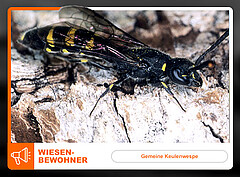Meadow fauna
The Common Club Wasp [08.12.22]

Image: Joachim Holstein
The females (at the end of the abdomen in the middle another yellow spot, in the males it is whitish colored) wait on the nesting aid for wild bees, which fill a cavity in wood with eggs and provisions (pollen and nectar): before the wild bee closes the cavity with a clay plug, for example, the club wasp lays an egg of its own.
In the sealed brood cell, the wasp larva hatches earlier than the wild bee larva, sucks out the bee egg, and then feeds on the stores. After several molts and the pupal stage, the adult club wasp hatches and works its way out through the closure of the cell.
After hatching, the males remain near the nest boxes and mate with the females immediately after they hatch.
Brood parasites with regulatory function
Mehr zum Thema |
Weniger mähen, mehr „Unordnung“ zulassen: Dazu will die Initiative „Bunte Wiese Stuttgart“ möglichst viele Menschen animieren. |
Incidentally, it can happen that not only one club wasp egg, but even several are laid in a wild bee cell. Then the hatched club wasp larvae fight with their dagger-like jaws (mandibles) until only one survives.
Club wasps overwinter as adults and are active from April to July. And they, too, need an abundant supply of flowers in their environment, as they feed on flower nectar, just like wild bees.
In the end, wild bee nesting owners wonder if wild bees can be protected from parasites? However, this parasitism is a natural process and if the population of wild bees in the nesting box collapses, the population of club wasps will also collapse. In addition, brood parasites have an important regulatory function: they prevent one species from reproducing excessively and thus displacing other species. Hence, brood parasites - such as the common club wasp - also make an important contribution to the preservation of our biodiversity!
Text: M. Rausch / Translation: Office of International Affairs